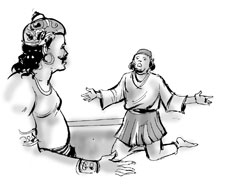1. It was with the
intention of getting the trade monopoly that the Portuguese tried to enter into a treaty with the king. It is the king, who held the trade monopoly at this time. In India too, the Portuguese did the same thing. They promised to protect the king and the princes from all
enemies and obtained the trade rights. Payo de Souza wanted a similar
agreement. The king of Portugal was very happy about the first visit of an European team of envoys to the Sinhala king. In fact, he gave a description of this to Rome as well.
2. The message sent to the Pope said, "We
discovered Taprobane."
This was good news to all Europeans of the day.
Payo de Souza who
visited the king's court described it in the following manner."At the end of a huge hall, there is a
beautiful throne, like an altar. Going by the
tradition of the country, the king was decked in all jewels and ornaments, made of very valuable gems.
3. Around him, on either side, there stood three men, holding large candles. The entire hall was lit with lamps on silver posts. In front of the hall, there were a number of
gentlemen, who belonged to the elite. At the centre of the hall, there was a passage leading up to the throne."
It was here, that the king
welcomed Payo de Souza and listened to the
proposals of the Portuguese envoy.
4. Later on, the king consented to grant what they wanted. The king had to give a good stock of
cinnamon annually. The first instalment was given then and there. According to the treaty, the Portuguese had to protect the harbours that belonged to the king. In return, the king had to give 400 'bahars' of cinnamon annually. As both parties agreed to the clauses of the treaty, it was duly signed.
5. 'Bahar' is a unit of measure which was then in use in the East. The scholars are of the opinion that it is derived from the Sanskrit word 'bhar.' However, the
actual weight of a 'bahar'
differed from
country to country. It roughly
amounted to about 400 – 500 pounds. According to the treaty, the Portuguese got permission to erect a store-room, in the headland. They soon started working on this.
6. These 'white people' erected a church on one side of the store. It was
dedicated to Saint Lorenzo, the saint of the leader of their fleet of ships. Lorenzo de Almeida had engraved the Portuguese emblem on a rock near the sea. He left a small contingent of naval officers, took the rest and went back.
7. The Muslims started protesting against the
existence of a Portuguese store in Colombo. This building did not take the shape of a room where goods were stored. Instead, it looked more like a Portuguese fortress. However small in size, this building was able to hold a small army. As such, the Muslims were able to create unrest among both the
people and the king,
showing the danger implied.
8. Their castigation proved successful. It went so far as to win the consent of the 'Yuvaraja.' As a result, in 1507 AD, the 'Yuvaraja' issued an order to pull down the building and to get all the soldiers who occupied the place to vacate it. |


